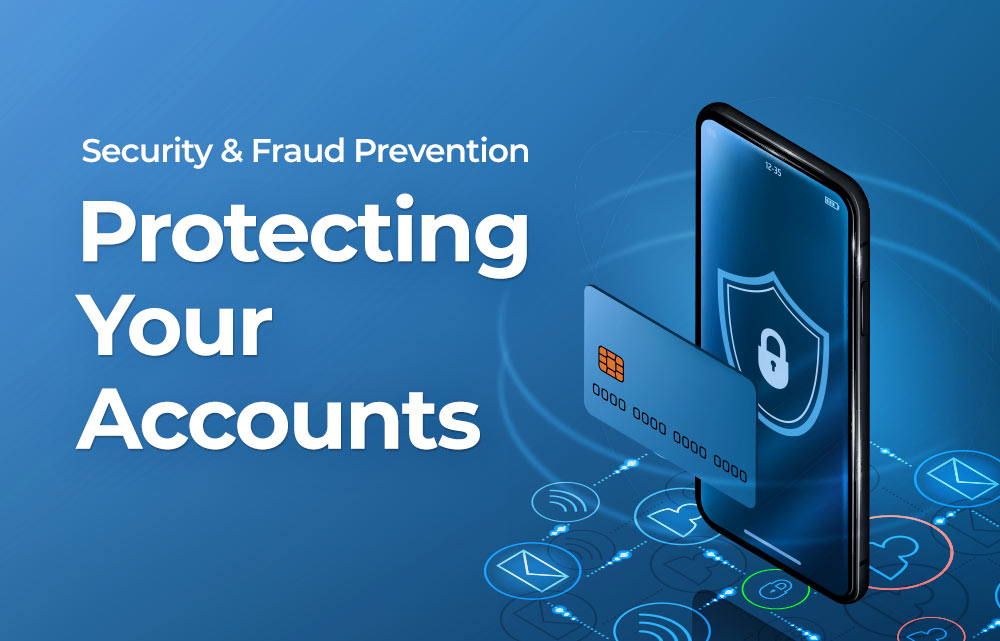Security & Fraud Prevention
Protecting
Your Accounts

Proactively Protect Your Accounts
With the advancement of digital banking, accessing your money has never been easier. But this can mean more opportunity for hackers and thieves.
Fraud exists everywhere. But taking these simple steps greatly reduces your risk and makes you a smaller target.
Make sure we know how to reach you at all times
Smart Financial must be able to reach you if you have suspicious activity on your accounts. Follow these easy steps to update your most recent phone, email and address as needed within Settings in Online or Mobile Banking.
Learn more and download the Smart Financial Mobile Banking App here
If you ever feel that your accounts may have been compromised, contact us immediately. There are immediate actions we can take to protect your accounts. For lost or stolen debit cards after hours, call 1-866-664-9364.
Create secure passwords and change them often
A strong password is the first line of defense against hackers. You should have a different password for every account, especially those that access your bank accounts or payment cards. Add an extra line of defense by enabling Touch ID or Face ID to log in on your mobile devices.
IMPORTANT: Smart Financial will never ask you for your Online Banking credentials.
Strong Password Strategy
Create a strong base password that you can use on all of your accounts.
1
Example of a strong base password:
2R%t$q0
Memorize this or store it somewhere safe.
Use all or part of the account name at the beginning and/or end of your password.
2
For example, your Amazon account:
AM2R%t$q0AZON
or
2R%t$q0AMAZ
Add an extra few characters to change up your passwords periodically.
3
For example, the quarter and year:
AM2R%t$q0AZON2Q21
or
2Q212R%t$q0AMAZ
Strong Password Strategy
Create a strong base password that you can use on all of your accounts.
1
Example of a strong base password:
2R%t$q0
Memorize this or store it somewhere safe.
Use all or part of the account name at the beginning and/or end of your password.
2
For example, your Amazon account:
AM2R%t$q0AZON
or
2R%t$q0AMAZ
Add an extra few characters to change up your passwords periodically.
3
For example, the quarter and year:
AM2R%t$q0AZON2Q21
or
2Q212R%t$q0AMAZ
Follow these easy steps to update your most recent phone
1
Log into Smart Financial Mobile App. Select More on tool bar at bottom of your Accounts page.
2
Select the icon in top right corner. This is your Settings menu.
3
Select the Contact menu and update your contact information. This is how we know where to reach you.
Set up two-factor authentication to prevent unauthorized access
When enabled, you will receive a one-time passcode every time you log in to Online Banking. The passcode is sent via SMS text to your confirmed mobile device or email address. If you ever receive a one-time passcode without prompting it, contact us immediately.
Use a desktop computer to log in to online banking in order to activate this security feature.
Set up Alerts to notify you of specified account activity
Set up Alerts in Online or Mobile Banking to receive a text or email when transactions occur based on the account activity you choose. For instance, receive a text every time someone uses your debit card for an amount over $500, or if your balance dips below $200. Find Alerts under More in the toolbar in Online & Mobile Banking.
Tip: Setting up an Online Banking Access Alert sends you a push notification, text, or email every time you log in. You would be alerted in real time if unauthorized access occurred.
Here are some other steps you can take
Take advantage of free security tools offered by our partners, such as MasterCard ID Theft Protection that comes with our Debit Cards. Learn more
Keep your devices updated with security patches and anti-virus software. Visit our Security Center for timely security related news & alerts.
Avoid shared connections like Wi-Fi and Bluetooth. When in public, use your carrier’s cellular connection logging into accounts containing sensitive data.
